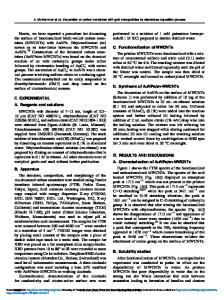Patterned Deposition of Nanoparticles Using Dip Pen Nanolithography For Synthesis of Carbon Nanotubes
- PDF / 683,875 Bytes
- 6 Pages / 612 x 792 pts (letter) Page_size
- 16 Downloads / 347 Views
Patterned Deposition of Nanoparticles Using Dip Pen Nanolithography For Synthesis of Carbon Nanotubes Kevin F. Dahlberg1, Kelly Woods1, Carol Jenkins1, Christine C. Broadbridge1,2, Todd C. Schwendemann1 1
Southern Physics Department, Southern Connecticut State University, New Haven, CT 2
Center for Research on Interface Structures and Phenomenon (CRISP), Southern Connecticut State University, New Haven, CT Abstract Ordered carbon nanotube (CNT) growth by deposition of nanoparticle catalysts using dip pen nanolithography (DPN) is presented. DPN is a direct write, tip based lithography technique capable of multi-component deposition of a wide range of materials with nanometer precision. A NanoInk NLP 2000 is used to pattern different catalytic nanoparticle solutions on various substrates. To generate a uniform pattern of nanoparticle clusters, various conditions need to be considered. These parameters include: the humidity in the vessel, temperature, and tip-surface dwell time. By patterning different nanoparticle solutions next to each other, identical growth conditions can be compared for different catalysts in a streamlined analysis process. Fe, Ni, and Co nanoparticle solutions patterned on silicon, mica, and graphite substrates serve as nucleation sites for CNT growth. The CNTs were synthesized by a chemical vapor deposition (CVD) reaction. Each nanoparticle patterned substrate is placed in a tube furnace held at 725˚C during CNT growth. The carbon source used in the growth chamber is toluene. The toluene is injected at a rate of 5 mL/hr. Growth is observed for Fe and Ni nanoparticle patterns, but is lacking for the Co patterns. The results of these reactions provide important information regarding efficient and highly reproducible mechanisms for CNT growth. Introduction Dip-Pen Nanolithography (DPN): The method of lithography as a means of transporting molecular ink to a canvas via capillary forces has been applied for hundreds of years. Only recently, since the incidental discovery of capillaries forming between atomic force microscope (AFM) tips and a sample, did the idea of a nanolithography technique seem feasible [1]. An array of AFM tips serve as a ‘pen’ which deposits a sub-microliter volume of molecular ink onto a substrate. A meniscus, which is formed as a result of the ambient humidity within the DPN apparatus, allows the molecules in the ink to be precisely deposited on the substrate in a predetermined pattern [1]. The two options of patterning are (1) top-down, where the AFM tip accrues a small water drop that adheres to the substrate, and (2) bottom-up, the case in which the liquid meniscus forms from the substrate and links to the bottom of the AFM tip [1]. The use of an array of AFM tips allows for a variety of ‘inks’ to be patterned in a parallel fashion under equivalent conditions. Parallel patterning makes DPN an effective tool in the field of nanotechnology; there are however, several other lithography techniques available such as microcontact printing or focused ion beam (FIB) lithography.
Data Loading...











